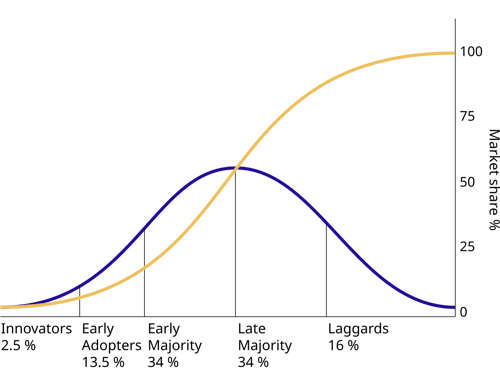Roger's Diffusion of Innovations
Describes how innovations spread among users.
"Thus we see that the diffusion of innovations is a social process, even more than a technical matter." 1

When new ideas or technologies are introduced in an Agile environment, not everyone embraces them at the same pace. Understanding how different groups respond to innovation is crucial for effective coaching, especially during transformation or product rollout. Everett Rogers' model outlines how innovations spread across a social system, categorizing people into groups like Innovators, Early Adopters, Early Majority, Late Majority, and Laggards. For Agile teams and organizations, this model helps us see why change often meets resistance, why adoption varies widely, and how to adapt strategies based on audience readiness.
Impact on Agile Organizations
Rogers' model reveals that no matter how promising a new Agile framework, product experiment, or cultural shift may be, the speed and style of its adoption will vary across teams and individuals. This uneven uptake can create friction, misalignment, or disengagement if not recognized early.
- Differentiated response to change:
- Innovators (2.5%): love experimentation and risk. They lead Agile pilots.
- Early Adopters (13.5%): opinion leaders who influence others once value becomes visible.
- Cultural gaps emerge across the curve:
- Early Majority (34%): require social proof and demonstrable success.
- Late Majority (34%): driven by peer pressure and fear of missing out.
- Laggards (16%): actively resist change, often tied to past solutions or legacy metrics.
- Frustration arises when:
- Leaders expect linear adoption but face a social system that adopts cyclically.
- Change agents misidentify where a team or department resides on the curve.
- Backlash grows from pushing laggards too early or not supporting early adopters enough.
Scenario
An organization launches dual-track Agile to integrate discovery and delivery. The Product Manager and one engineer, both early adopters, champion continuous discovery interviews and experiments. A few others cautiously observe. But most of the team avoids the discovery work, sticking to delivery tasks. The Product Owner, aligned with legacy delivery models, questions the need for "all this talking to users".
- Innovators and early adopters create discovery rituals and tools.
- The early majority remains skeptical until success stories are framed in delivery terms.
- Late majority watches for policy or compliance signals before participating.
- Laggards see the initiative as disruptive noise.
The Product Manager, frustrated, begins to think the organization "just isn't innovative", when in fact, the diffusion curve is unfolding naturally.
Ways to Mitigate Adoption Challenges:
Recognizing where people fall on the adoption curve enables more nuanced, human-centered change strategies. Instead of treating resistance as failure, we treat it as a signal for differentiated engagement.
- Adjust Messaging and Timing:
- Tailor communications to match adopter profile:
- emphasize experimentation with innovators, ROI and stories with early/late majority.
- Tailor communications to match adopter profile:
- Create multiple Onramps:
- Build opt-in pilot programs with high visibility and internal storytelling.
- Ensure late adopters have access to structured training and peer mentoring.
- Invest in Social Proof:
- Share wins and data from early adopters to influence the middle of the curve.
- Recruit respected early majority members to co-lead scaling efforts.
- Avoid Over-Focusing on the Laggards:
- Make participation attractive, not mandatory.
- Let success become the motivator rather than pressure or shame.
Conclusion:
Rogers' Diffusion of Innovations explains why change, even when valuable, spreads unevenly. It's a map of social readiness, not a prescription for uniform action. Agile transformation efforts often falter not because the ideas are flawed, but because leaders ignore the dynamics of adoption. As coaches, we must meet people where they are.
- Not everyone resists change. Some are simply not yet convinced.
- Social influence plays a stronger role than formal authority in adoption.
- Agile change management must account for timing, trust, and tribe.
Key Takeaways
- Innovation adoption occurs in predictable social patterns, not all at once.
- Early adopters need space to experiment, while later groups need stories and proof.
- Mistaking laggards for blockers can create unnecessary tension.
- Agile rollouts should be staged and socially aware, not purely procedural.
- Support must evolve over time to match changing adopter needs.
Summary
Agile transformations succeed when we recognize that people adopt change at different rates. Rogers' model offers a clear framework for guiding that adoption with empathy and strategy. By adjusting our expectations and approach based on where individuals or teams fall on the curve, we avoid frustration, build momentum, and create sustainable cultural shifts. Agile teams do not need everyone to adopt at once. They need leaders who understand the shape of adoption and build trust accordingly.